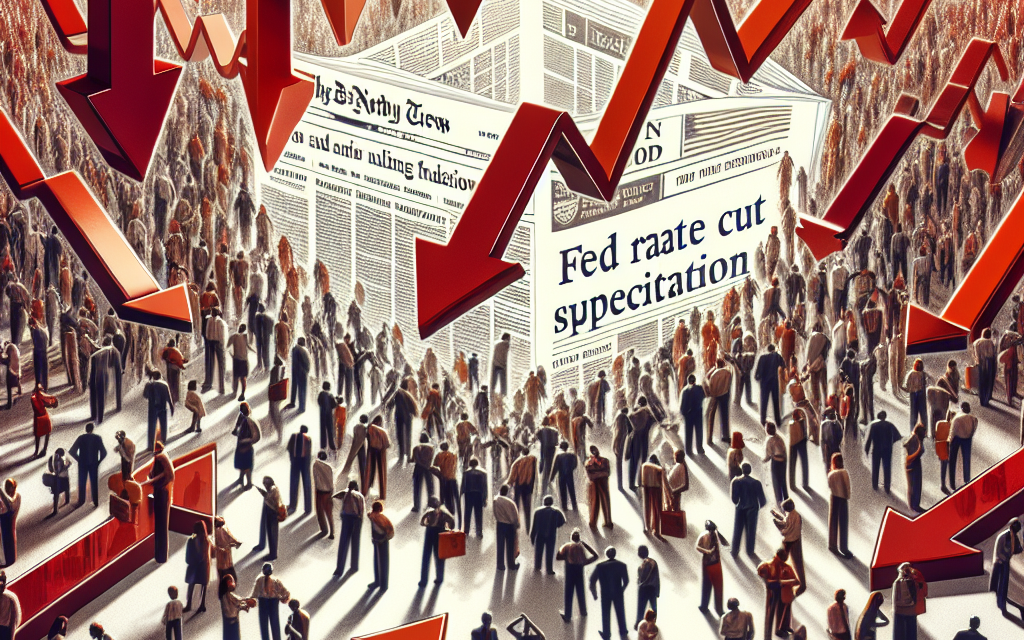“Uncertainty Reigns: Markets Sway as Fed Rate Cut Speculation Heats Up”
Introduction
Market turmoil has intensified as speculation mounts over potential interest rate cuts by the Federal Reserve. Investors are grappling with heightened volatility, driven by uncertainty surrounding the central bank’s monetary policy direction. The anticipation of rate adjustments has led to significant fluctuations in stock prices, bond yields, and currency valuations, reflecting the market’s sensitivity to economic indicators and policy signals. As traders and analysts closely monitor the Fed’s communications and economic data releases, the financial landscape remains on edge, with the potential for further disruptions as expectations evolve.
Impact Of Fed Rate Cut Speculation On Global Markets
The global financial markets have been experiencing heightened volatility as speculation intensifies over potential interest rate cuts by the Federal Reserve. Investors worldwide are closely monitoring the Fed’s actions, as any decision to alter interest rates can have far-reaching implications across various asset classes. The anticipation of a rate cut has led to significant fluctuations in stock prices, bond yields, and currency values, reflecting the uncertainty that currently pervades the markets.
To begin with, the stock markets have been particularly sensitive to the speculation surrounding the Fed’s potential rate cut. Historically, lower interest rates tend to boost stock prices as they reduce borrowing costs for companies, potentially leading to increased investment and expansion. However, the current situation is more complex. While some investors are optimistic about the prospect of cheaper credit, others are concerned that a rate cut might signal underlying weaknesses in the economy. This dichotomy has resulted in erratic trading patterns, with major indices experiencing sharp swings as market participants react to each new piece of economic data and commentary from Fed officials.
In the bond markets, the speculation has led to a decline in yields, as investors anticipate that a rate cut would make existing bonds with higher interest rates more attractive. This has resulted in increased demand for government securities, driving their prices up and yields down. The yield curve, which plots the interest rates of bonds with different maturities, has also been closely watched. An inversion of the yield curve, where short-term rates exceed long-term rates, is often seen as a predictor of an economic downturn. The current flattening of the yield curve has added to the anxiety among investors, as they weigh the potential implications of the Fed’s next move.
Currency markets have not been immune to the turmoil either. The U.S. dollar, which typically strengthens when interest rates rise, has faced downward pressure amid expectations of a rate cut. A weaker dollar can have mixed effects on the global economy. On one hand, it can boost U.S. exports by making them cheaper for foreign buyers. On the other hand, it can lead to capital outflows from emerging markets, as investors seek higher returns elsewhere. This dynamic has created additional layers of complexity for policymakers and investors alike, as they navigate the interconnectedness of global financial systems.
Moreover, the speculation over the Fed’s actions has not occurred in isolation. It is set against a backdrop of broader economic concerns, including trade tensions, geopolitical uncertainties, and slowing growth in major economies. These factors have compounded the challenges faced by central banks around the world, as they strive to balance the need for economic stimulus with the risks of inflation and financial instability. The Fed’s decision-making process is further complicated by the need to maintain its credibility and independence, particularly in the face of political pressures.
In conclusion, the speculation surrounding a potential Fed rate cut has intensified market turmoil, affecting stocks, bonds, and currencies on a global scale. As investors grapple with the implications of such a move, the broader economic context adds layers of complexity to an already uncertain environment. The coming weeks will be crucial as market participants await clearer signals from the Federal Reserve, hoping for guidance that could stabilize the current volatility and provide a clearer path forward for the global economy.
Investor Strategies During Market Volatility
In recent weeks, the financial markets have been gripped by heightened volatility, driven largely by speculation surrounding potential interest rate cuts by the Federal Reserve. Investors, both seasoned and novice, find themselves navigating a complex landscape where uncertainty reigns supreme. As market participants grapple with the implications of possible monetary policy shifts, it becomes imperative to explore strategies that can help mitigate risks and capitalize on opportunities during such turbulent times.
To begin with, diversification remains a cornerstone of prudent investment strategy, particularly in volatile markets. By spreading investments across a variety of asset classes, sectors, and geographies, investors can reduce the impact of adverse movements in any single area. This approach not only helps in cushioning the portfolio against market shocks but also positions investors to benefit from potential upswings in different segments. For instance, while equities may experience fluctuations, bonds or commodities might offer stability or even growth, thereby balancing the overall portfolio performance.
Moreover, maintaining a long-term perspective is crucial when navigating market volatility. Short-term market movements, often driven by speculation and sentiment, can lead to impulsive decision-making that may not align with an investor’s financial goals. By focusing on long-term objectives and adhering to a well-defined investment plan, investors can avoid the pitfalls of reacting to temporary market noise. This disciplined approach allows for the compounding of returns over time, which is a powerful driver of wealth accumulation.
In addition to diversification and a long-term outlook, investors should also consider the role of liquidity in their portfolios. During periods of market turmoil, having access to liquid assets can provide the flexibility needed to respond to changing conditions. Liquid assets, such as cash or short-term government securities, can serve as a buffer against market downturns and offer the opportunity to purchase undervalued assets when prices are depressed. This strategic liquidity management can enhance an investor’s ability to navigate volatile markets effectively.
Furthermore, it is essential for investors to stay informed and vigilant about macroeconomic indicators and central bank communications. Understanding the broader economic context and the potential implications of monetary policy decisions can provide valuable insights into market dynamics. By keeping abreast of economic data releases, Federal Reserve statements, and geopolitical developments, investors can make more informed decisions and adjust their strategies accordingly.
In light of the current market environment, risk management becomes a critical component of any investment strategy. Employing tools such as stop-loss orders, options, or hedging techniques can help protect portfolios from significant losses. These risk management strategies allow investors to set predefined exit points or offset potential declines, thereby preserving capital during uncertain times.
Finally, seeking professional advice can be beneficial for investors who may feel overwhelmed by market volatility. Financial advisors can offer personalized guidance, helping investors to align their strategies with their risk tolerance and financial goals. By leveraging the expertise of professionals, investors can gain confidence in their decision-making process and enhance their ability to navigate challenging market conditions.
In conclusion, while market volatility can be unsettling, it also presents opportunities for those who are prepared. By employing a combination of diversification, long-term focus, liquidity management, informed decision-making, risk management, and professional guidance, investors can position themselves to weather the storm and potentially emerge stronger. As speculation about Federal Reserve rate cuts continues to influence market sentiment, adopting these strategies can help investors maintain resilience and adaptability in the face of uncertainty.
Historical Analysis Of Fed Rate Cuts And Market Reactions
The history of Federal Reserve rate cuts offers a rich tapestry of insights into how financial markets react to monetary policy shifts. Understanding these historical patterns is crucial, especially as speculation about potential rate cuts intensifies. Historically, the Federal Reserve has employed rate cuts as a tool to stimulate economic activity during periods of economic downturn or financial instability. By lowering interest rates, the Fed aims to make borrowing cheaper, thereby encouraging spending and investment. However, the market’s reaction to such cuts is not always straightforward and can vary significantly depending on the broader economic context.
To illustrate, the rate cuts during the early 2000s, following the dot-com bubble burst, were met with a relatively positive market response. Investors viewed these cuts as a proactive measure to support economic recovery, leading to a gradual rebound in stock prices. Similarly, during the 2008 financial crisis, the Fed’s aggressive rate cuts were initially met with volatility, but eventually, they helped stabilize the financial system and restore investor confidence. These instances highlight that while rate cuts can be a powerful tool for economic recovery, their immediate impact on markets can be unpredictable.
Moreover, the market’s reaction to rate cuts is often influenced by the underlying reasons for the Fed’s decision. For instance, if rate cuts are perceived as a response to a weakening economy, investor sentiment may sour, leading to market declines. Conversely, if cuts are seen as a preemptive measure to sustain growth, markets may react more favorably. This duality was evident in 2019 when the Fed cut rates amid trade tensions and global growth concerns. The market’s response was mixed, reflecting uncertainty about the economic outlook.
In addition to the economic context, investor expectations play a crucial role in shaping market reactions to rate cuts. When rate cuts are anticipated, markets often price in these expectations well in advance, leading to muted reactions when the cuts are finally announced. Conversely, unexpected rate cuts can lead to significant market volatility as investors scramble to adjust their portfolios. This was evident in March 2020 when the Fed implemented an emergency rate cut in response to the COVID-19 pandemic. The unexpected nature of the cut led to sharp market fluctuations as investors grappled with the rapidly evolving economic landscape.
Furthermore, the effectiveness of rate cuts in influencing market behavior can be affected by other factors, such as fiscal policy measures and global economic conditions. For example, during periods of synchronized global economic slowdown, the impact of Fed rate cuts may be dampened by external factors beyond the Fed’s control. Similarly, if fiscal policy is not aligned with monetary policy, the effectiveness of rate cuts in stimulating economic activity may be limited.
In conclusion, while historical analysis of Fed rate cuts provides valuable insights into potential market reactions, it is essential to consider the broader economic context, investor expectations, and other influencing factors. As speculation about future rate cuts intensifies, understanding these dynamics can help investors navigate the complexities of market behavior. Ultimately, while history may not repeat itself exactly, it often rhymes, offering lessons that can guide decision-making in times of uncertainty.
Sector-Specific Effects Of Potential Fed Rate Adjustments

The financial markets are currently experiencing heightened volatility as speculation mounts over potential adjustments to the Federal Reserve’s interest rate policy. This uncertainty is reverberating across various sectors, each responding in distinct ways to the prospect of a rate cut. Understanding these sector-specific effects is crucial for investors and stakeholders aiming to navigate the turbulent economic landscape.
To begin with, the banking sector is particularly sensitive to changes in interest rates. Banks typically benefit from higher rates, which allow them to charge more for loans relative to the interest they pay on deposits. Consequently, the anticipation of a rate cut has led to a decline in bank stocks, as investors foresee a potential squeeze on profit margins. However, it is worth noting that lower rates could stimulate borrowing, potentially offsetting some of the negative impacts on banks’ earnings.
In contrast, the real estate sector often welcomes lower interest rates, as they tend to reduce the cost of borrowing for homebuyers and developers. This can lead to increased activity in the housing market, driving up property values and benefiting real estate investment trusts (REITs). Nevertheless, the current market turmoil adds a layer of complexity, as economic uncertainty may dampen consumer confidence and delay purchasing decisions, even in a low-rate environment.
The technology sector, known for its growth-oriented companies, also stands to gain from a potential rate cut. Lower borrowing costs can facilitate investment in innovation and expansion, providing tech firms with the capital needed to develop new products and services. Moreover, as investors seek higher returns in a low-rate environment, they may be more inclined to invest in tech stocks, which are often perceived as offering substantial growth potential. However, the sector is not immune to broader market volatility, which can lead to fluctuations in stock prices despite favorable interest rate conditions.
Meanwhile, the consumer goods sector presents a more nuanced picture. On one hand, lower interest rates can boost consumer spending by reducing the cost of credit, thereby benefiting companies that produce non-durable goods. On the other hand, durable goods manufacturers may face challenges if economic uncertainty leads consumers to postpone big-ticket purchases. Additionally, companies with significant international exposure must contend with currency fluctuations, as rate cuts can weaken the dollar and impact global trade dynamics.
The energy sector, too, is influenced by interest rate expectations, albeit in a more indirect manner. Lower rates can stimulate economic activity, potentially increasing demand for energy. However, the sector is also heavily influenced by geopolitical factors and supply chain dynamics, which can overshadow the effects of domestic monetary policy. Furthermore, energy companies with high levels of debt may benefit from reduced borrowing costs, improving their financial stability in a volatile market.
In conclusion, the speculation surrounding potential Federal Reserve rate cuts is creating a complex tapestry of effects across different sectors. While some industries stand to benefit from lower borrowing costs, others face challenges due to squeezed margins or delayed consumer spending. As market participants grapple with these dynamics, it is essential to consider both the direct and indirect implications of interest rate adjustments. By doing so, investors and stakeholders can better position themselves to navigate the ongoing market turmoil and capitalize on emerging opportunities.
Comparing Current Market Turmoil With Past Economic Crises
The current market turmoil, characterized by heightened volatility and investor anxiety, has drawn comparisons to past economic crises, prompting analysts to examine the underlying causes and potential outcomes. As speculation mounts over the Federal Reserve’s next move regarding interest rate cuts, it is essential to understand how today’s financial landscape parallels and diverges from previous periods of economic distress. By exploring these similarities and differences, we can gain a clearer perspective on the potential trajectory of the current market situation.
Historically, economic crises have often been precipitated by a combination of factors, including excessive leverage, asset bubbles, and external shocks. The 2008 financial crisis, for instance, was largely driven by the collapse of the housing market and the subsequent unraveling of complex financial instruments tied to mortgage-backed securities. In contrast, the current market turmoil is primarily fueled by uncertainty surrounding monetary policy, geopolitical tensions, and the lingering effects of the COVID-19 pandemic. While the root causes may differ, the resulting market instability and investor apprehension bear a striking resemblance to past crises.
One notable similarity between the current market environment and previous economic downturns is the role of central banks in attempting to stabilize financial systems. During the 2008 crisis, the Federal Reserve and other central banks around the world implemented aggressive monetary policies, including slashing interest rates and launching quantitative easing programs, to restore confidence and liquidity. Today, the Federal Reserve faces a similar challenge as it navigates the delicate balance between curbing inflation and supporting economic growth. Speculation over potential rate cuts has intensified, with investors closely monitoring the Fed’s communications for any indication of a shift in policy direction.
Despite these parallels, there are also significant differences that set the current market turmoil apart from past crises. For one, the global economy is now more interconnected than ever before, with supply chains spanning multiple countries and regions. This interconnectedness has amplified the impact of geopolitical events, such as trade tensions and conflicts, on financial markets. Additionally, the rapid pace of technological advancement has introduced new variables into the economic equation, including the rise of digital currencies and the increasing influence of algorithmic trading. These factors contribute to a more complex and dynamic market environment, complicating efforts to predict and manage potential crises.
Moreover, the lessons learned from past economic downturns have equipped policymakers and financial institutions with a better understanding of how to mitigate the effects of market turmoil. Regulatory reforms implemented in the wake of the 2008 crisis, such as stricter capital requirements and enhanced oversight of financial institutions, have strengthened the resilience of the global financial system. However, these measures are not foolproof, and the current market volatility serves as a reminder of the inherent unpredictability of financial markets.
In conclusion, while the current market turmoil shares certain characteristics with past economic crises, it is also shaped by unique factors that reflect the evolving nature of the global economy. As speculation over Federal Reserve rate cuts continues to dominate headlines, it is crucial for investors and policymakers alike to remain vigilant and adaptable in the face of uncertainty. By drawing on historical insights and embracing innovative solutions, we can better navigate the challenges of today’s financial landscape and work towards a more stable and prosperous future.
The Role Of Central Banks In Stabilizing Financial Markets
In recent months, the global financial markets have been gripped by heightened volatility, largely driven by speculation surrounding potential interest rate cuts by the Federal Reserve. This uncertainty has underscored the pivotal role central banks play in stabilizing financial markets, as investors closely monitor their actions and communications for guidance. Central banks, particularly the Federal Reserve, are tasked with the dual mandate of fostering economic growth and maintaining price stability. In times of market turmoil, their role becomes even more critical as they navigate the delicate balance between stimulating the economy and preventing inflationary pressures.
The anticipation of a rate cut by the Federal Reserve has been fueled by a confluence of factors, including slowing economic growth, trade tensions, and geopolitical uncertainties. These elements have collectively contributed to a climate of apprehension among investors, prompting them to seek refuge in safer assets. Consequently, stock markets have experienced significant fluctuations, with investors reacting to every hint of policy change. In this context, the Federal Reserve’s communication strategy becomes paramount, as it seeks to manage market expectations and prevent undue panic.
Central banks employ a range of tools to stabilize financial markets, with interest rate adjustments being one of the most potent. By lowering interest rates, central banks can encourage borrowing and investment, thereby stimulating economic activity. However, the decision to cut rates is not taken lightly, as it involves careful consideration of various economic indicators and potential long-term consequences. Moreover, central banks must also weigh the risk of igniting inflation against the need to support growth, a task that requires a nuanced understanding of the economic landscape.
In addition to interest rate policies, central banks also utilize other mechanisms such as open market operations and quantitative easing to influence market conditions. These tools allow central banks to inject liquidity into the financial system, thereby ensuring that credit flows smoothly and markets remain functional. During periods of market stress, such interventions can provide much-needed reassurance to investors, helping to restore confidence and stability.
The role of central banks extends beyond domestic borders, as their actions can have far-reaching implications for global financial markets. In an interconnected world, policy decisions made by major central banks like the Federal Reserve can trigger ripple effects across economies, influencing exchange rates, capital flows, and investment decisions. As such, central banks must also consider the international ramifications of their policies, particularly in times of heightened market sensitivity.
While central banks play a crucial role in stabilizing financial markets, it is important to recognize that their actions are not a panacea for all economic challenges. Structural issues, such as fiscal imbalances and regulatory shortcomings, also need to be addressed to ensure long-term stability. Therefore, a coordinated approach involving both monetary and fiscal policies is essential to effectively navigate periods of market turmoil.
In conclusion, the speculation surrounding potential rate cuts by the Federal Reserve has highlighted the critical role central banks play in stabilizing financial markets. Through their policy tools and communication strategies, central banks strive to manage market expectations and maintain economic stability. However, their actions must be complemented by broader policy measures to address underlying economic challenges. As the global economy continues to face uncertainties, the role of central banks in guiding markets through turbulent times remains indispensable.
Long-Term Implications Of Frequent Fed Rate Changes
The financial markets have been experiencing heightened volatility as speculation mounts over potential interest rate cuts by the Federal Reserve. This speculation has not only stirred short-term market fluctuations but also raised questions about the long-term implications of frequent changes in the Fed’s monetary policy. Historically, the Federal Reserve has used interest rate adjustments as a tool to manage economic growth and control inflation. However, the increasing frequency of these changes has led to a complex landscape that investors and policymakers must navigate with caution.
To begin with, frequent rate changes can create an environment of uncertainty, which may deter long-term investment. Investors typically seek stability and predictability to make informed decisions about where to allocate their resources. When the Federal Reserve frequently alters interest rates, it can lead to a lack of confidence in the market’s future trajectory. This uncertainty can result in reduced capital investment, as businesses may hesitate to commit to long-term projects without a clear understanding of future borrowing costs. Consequently, this can slow economic growth, as investment is a critical driver of productivity and innovation.
Moreover, the impact of frequent rate changes extends beyond the domestic economy, influencing global financial markets. The United States, being a major economic powerhouse, plays a significant role in the global financial system. Changes in U.S. interest rates can lead to capital flows across borders, affecting exchange rates and economic conditions in other countries. For instance, a rate cut by the Fed might lead to a depreciation of the U.S. dollar, prompting other nations to adjust their monetary policies to maintain competitive exchange rates. This interconnectedness means that frequent rate changes can contribute to global economic instability, as countries react to shifts in U.S. policy.
In addition to these global considerations, frequent rate changes can also impact consumer behavior. Interest rates influence borrowing costs for consumers, affecting their spending and saving decisions. When rates are cut, borrowing becomes cheaper, potentially encouraging consumer spending and boosting economic activity in the short term. However, if rate changes occur too frequently, consumers may become cautious, unsure of how long favorable borrowing conditions will last. This uncertainty can lead to erratic spending patterns, complicating efforts to achieve sustainable economic growth.
Furthermore, the credibility of the Federal Reserve is at stake when it frequently alters interest rates. The Fed’s primary mandate is to ensure price stability and full employment, and its actions are closely scrutinized by market participants. If the Fed is perceived as reacting too hastily or inconsistently, it may undermine its credibility, making it more challenging to manage expectations and achieve its policy objectives. Maintaining a balance between responsiveness to economic conditions and the need for stability is crucial for preserving the Fed’s reputation as a reliable steward of monetary policy.
In conclusion, while the Federal Reserve’s interest rate decisions are essential tools for managing the economy, the long-term implications of frequent rate changes warrant careful consideration. The potential for increased market uncertainty, global economic repercussions, altered consumer behavior, and challenges to the Fed’s credibility all underscore the need for a measured approach. As speculation about future rate cuts continues to intensify, it is imperative for policymakers to weigh the short-term benefits against the long-term consequences, ensuring that monetary policy remains a stabilizing force in an ever-evolving economic landscape.
Q&A
1. **What is causing the market turmoil?**
Market turmoil is being driven by speculation about potential interest rate cuts by the Federal Reserve, which is creating uncertainty among investors.
2. **How are investors reacting to the speculation of a Fed rate cut?**
Investors are reacting with increased volatility in the markets, as they adjust their portfolios in anticipation of possible changes in monetary policy.
3. **What sectors are most affected by the market turmoil?**
Financials, technology, and consumer discretionary sectors are often most affected, as they are sensitive to interest rate changes and economic outlooks.
4. **How do Fed rate cuts typically impact the stock market?**
Fed rate cuts can lead to lower borrowing costs, potentially boosting stock prices, but they can also signal economic weakness, which might lead to market declines.
5. **What are the potential benefits of a Fed rate cut?**
A Fed rate cut can stimulate economic growth by making borrowing cheaper for consumers and businesses, potentially leading to increased spending and investment.
6. **What are the risks associated with a Fed rate cut?**
Risks include the possibility of inflation rising if the economy overheats, and the perception that the Fed is reacting to economic weakness, which can undermine investor confidence.
7. **How might global markets be affected by U.S. Fed rate cut speculation?**
Global markets might experience increased volatility, as changes in U.S. monetary policy can influence global capital flows, exchange rates, and economic conditions.
Conclusion
The intensifying market turmoil amid speculation of a Federal Reserve rate cut underscores the heightened uncertainty and volatility in the financial markets. Investors are grappling with mixed signals from economic indicators, geopolitical tensions, and the Fed’s policy direction, leading to fluctuating asset prices and increased risk aversion. The anticipation of a rate cut reflects concerns over slowing economic growth and potential recessionary pressures, prompting market participants to reassess their investment strategies. As the Fed navigates these complex dynamics, its decisions will be pivotal in shaping market sentiment and economic stability in the coming months.





